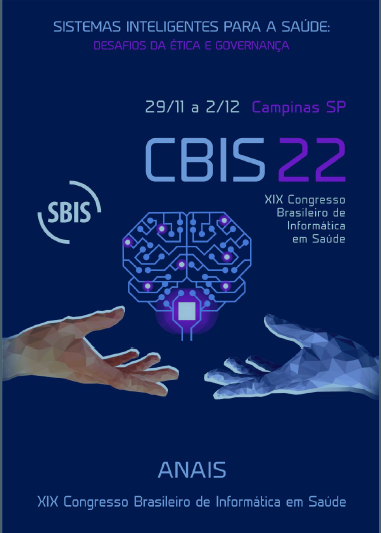Validation of a chatbot as a tool for monitoring of chronic pain
DOI:
https://doi.org/10.59681/2175-4411.v15.iEspecial.2023.1076Palavras-chave:
Chronic Pain, Clinical Evolution, Computer SystemsResumo
In this work we studied the use of a chatbot as a monitoring tool for chronic pain. An anamnesis was performed on 28 patients, and afterward, the pain intensity response of each patient was collected by the therapist and the chatbot. It was obtained a strong correlation of 0.94 between the pain intensity collected by the therapist and the chatbot. We noted that 50% of the answers to the chatbot were recorded about 30 minutes after the message was sent. Patients in the age range of 30-60 years responded quicker than others. With respect to gender, male patients answered quicker the chatbot on average. As far as the answers were recorded over the days by the chatbot, the answers recorded diminished approximately linearly. We validated the chatbot as an efficient monitoring of the pain's intensity, being an easy interactive tool showing good adhesion by the patients
Referências
Vasconcelos FH, Araújo GC de. Prevalence of chronic pain in Brazil: a descriptive study. Brazilian Journal Of Pain [Internet]. 2018 [citado 25 de julho de 2022];1(2). Disponível em: http://www.scielo.br/scielo.php?script=sci_arttext&pid=S2595-31922018000200176&lng=en&nrm=iso&tlng=en
Cohen SP, Vase L, Hooten WM. Chronic pain: an update on burden, best practices, and new advances. The Lancet. maio de 2021;397(10289):2082–97.
Dahlhamer J, Lucas J, Zelaya C, Nahin R, Mackey S, DeBar L, et al. Prevalence of Chronic Pain and High-Impact Chronic Pain Among Adults - United States, 2016. MMWR Morb Mortal Wkly Rep. 14 de setembro de 2018;67(36):1001–6.
Fayaz A, Croft P, Langford RM, Donaldson LJ, Jones GT. Prevalence of chronic pain in the UK: a systematic review and meta-analysis of population studies. BMJ Open. 20 de junho de 2016;6(6):e010364.
Aguiar DP, Souza CP de Q, Barbosa WJM, Santos-Júnior FFU, Oliveira AS de. Prevalence of chronic pain in Brazil: systematic review. Brazilian Journal Of Pain [Internet]. 2021 [citado 26 de julho de 2022]; Disponível em: http://www.scielo.br/scielo.php?script=sci_issues&pid=2595-3192&lng=en&nrm=isso
Hauser-Ulrich S, Künzli H, Meier-Peterhans D, Kowatsch T. A Smartphone-Based Health Care Chatbot to Promote Self-Management of Chronic Pain (SELMA): Pilot Randomized Controlled Trial. JMIR Mhealth Uhealth. 3 de abril de 2020;8(4):e15806.
Vugts MAP, Joosen MCW, van der Geer JE, Zedlitz AMEE, Vrijhoef HJM. The effectiveness of various computer-based interventions for patients with chronic pain or functional somatic syndromes: A systematic review and meta-analysis. Yang J, organizador. PLoS ONE. 16 de maio de 2018;13(5):e0196467.
Nicholl BI, Sandal LF, Stochkendahl MJ, McCallum M, Suresh N, Vasseljen O, et al. Digital Support Interventions for the Self-Management of Low Back Pain: A Systematic Review. J Med Internet Res. 21 de maio de 2017;19(5):e179.
Bickmore TW, Mitchell SE, Jack BW, Paasche-Orlow MK, Pfeifer LM, Odonnell J. Response to a Relational Agent by Hospital Patients with Depressive Symptoms. Interact Comput. 1o de julho de 2010;22(4):289–98.
Chung K, Park RC. Chatbot-based heathcare service with a knowledge base for cloud computing. Cluster Comput. janeiro de 2019;22(S1):1925–37.
Goldenthal SB, Portney D, Steppe E, Ghani K, Ellimoottil C. Assessing the feasibility of a chatbot after ureteroscopy. Mhealth. 2019;5:8.
Fitzpatrick TB. The validity and practicality of sun-reactive skin types I through VI. Archives of Dermatology. 1o de junho de 1988;124(6):869–71.
Weltgesundheitsorganisation. The SuRF report 2: surveillance of chronic disease risk factors : country-level data and comparable estimates. Geneva: World Health Organization; 2005.
de David CN, Deligne L de MC, da Silva RS, Malta DC, Duncan BB, Passos VM de A, et al. The burden of low back pain in Brazil: estimates from the Global Burden of Disease 2017 Study. Popul Health Metrics. setembro de 2020;18(S1):12.
Bento TPF, Genebra CV dos S, Maciel NM, Cornelio GP, Simeão SFAP, Vitta A de. Low back pain and some associated factors: is there any difference between genders? Brazilian Journal of Physical Therapy. janeiro de 2020;24(1):79–87.
Cateb GF, Amaral S, Gonçalves SCL, Oliveira IJR, Prates RO, Chagas BA, et al. Estudo piloto de validação de um chatbot de rastreamento, implementado para direcionar a teleassistência em COVID-19. Em: Anais Estendidos do XXI Simpósio Brasileiro de Computação Aplicada à Saúde (SBCAS Estendido 2021) [Internet]. Brasil: Sociedade Brasileira de Computação (SBC); 2021 [citado 2 de agosto de 2022]. p. 97–102. Disponível em: https://sol.sbc.org.br/index.php/sbcas_estendido/article/view/16108
Fan X, Chao D, Zhang Z, Wang D, Li X, Tian F. Utilization of Self-Diagnosis Health Chatbots in Real-World Settings: Case Study. J Med Internet Res. 6 de janeiro de 2021;23(1):e19928.
Downloads
Publicado
Como Citar
Edição
Secção
Licença
Direitos de Autor (c) 2023 Vagner Zeizer Carvalho Paes, Ana Carolina de Magalhães, Nathali Cordeiro Pinto, Thaís da Silva Veriato, Marcelo Victor Pires de Sousa, Thereza Cury Fortunato

Este trabalho encontra-se publicado com a Licença Internacional Creative Commons Atribuição-NãoComercial-CompartilhaIgual 4.0.
A submissão de um artigo ao Journal of Health Informatics é entendida como exclusiva e que não está sendo considerada para publicação em outra revista. A permissão dos autores para a publicação de seu artigo no J. Health Inform. implica na exclusiva autorização concedida aos editores para incluí-lo na revista. Ao submeter um artigo, ao autor será solicitada a permissão eletrônica de um Termo de Transferência de Direitos Autorais. Uma mensagem eletrônica será enviada ao autor correspondente confirmando o recibo do manuscrito e o aceite da Declaração de Direito Autoral.


